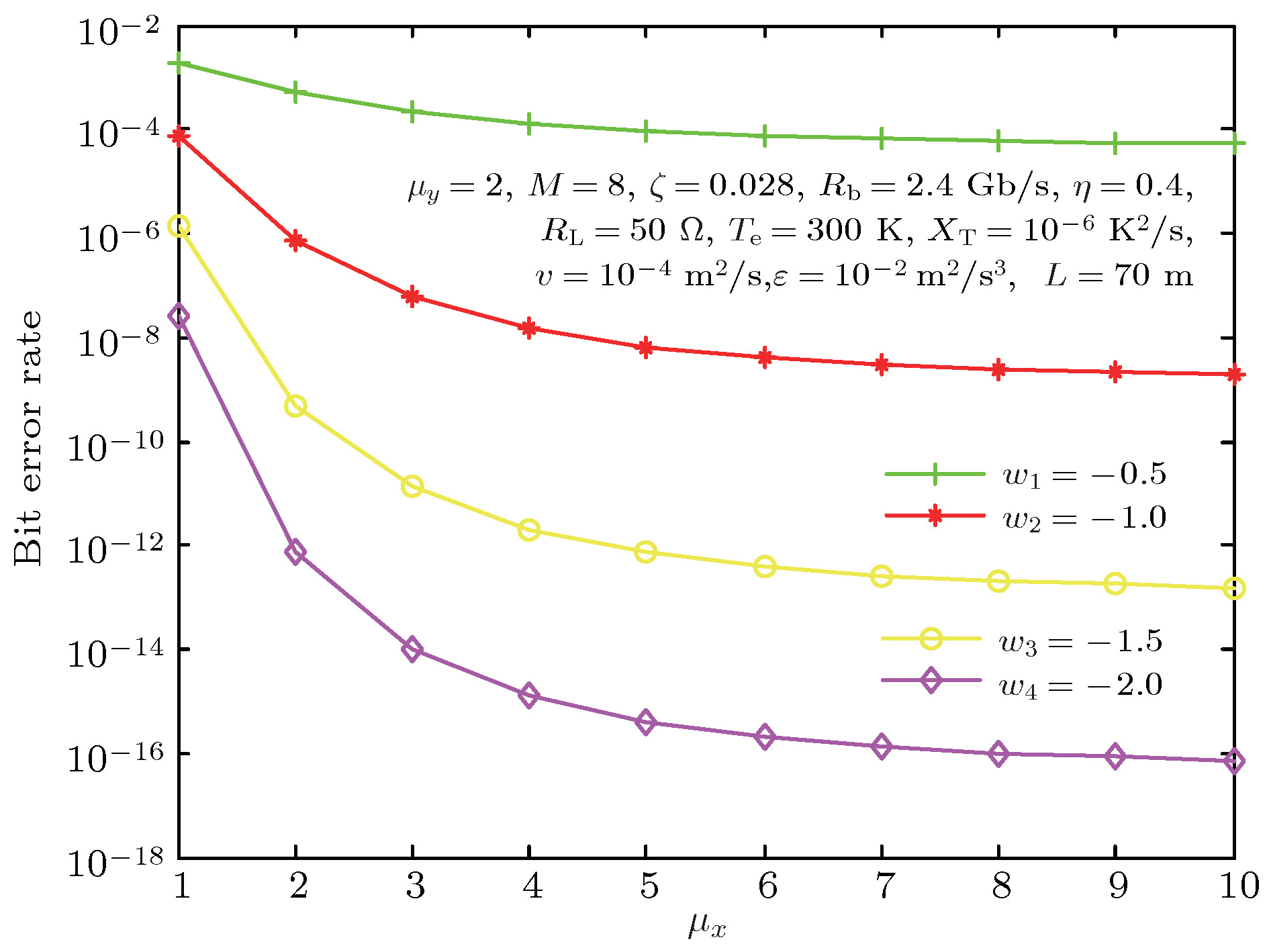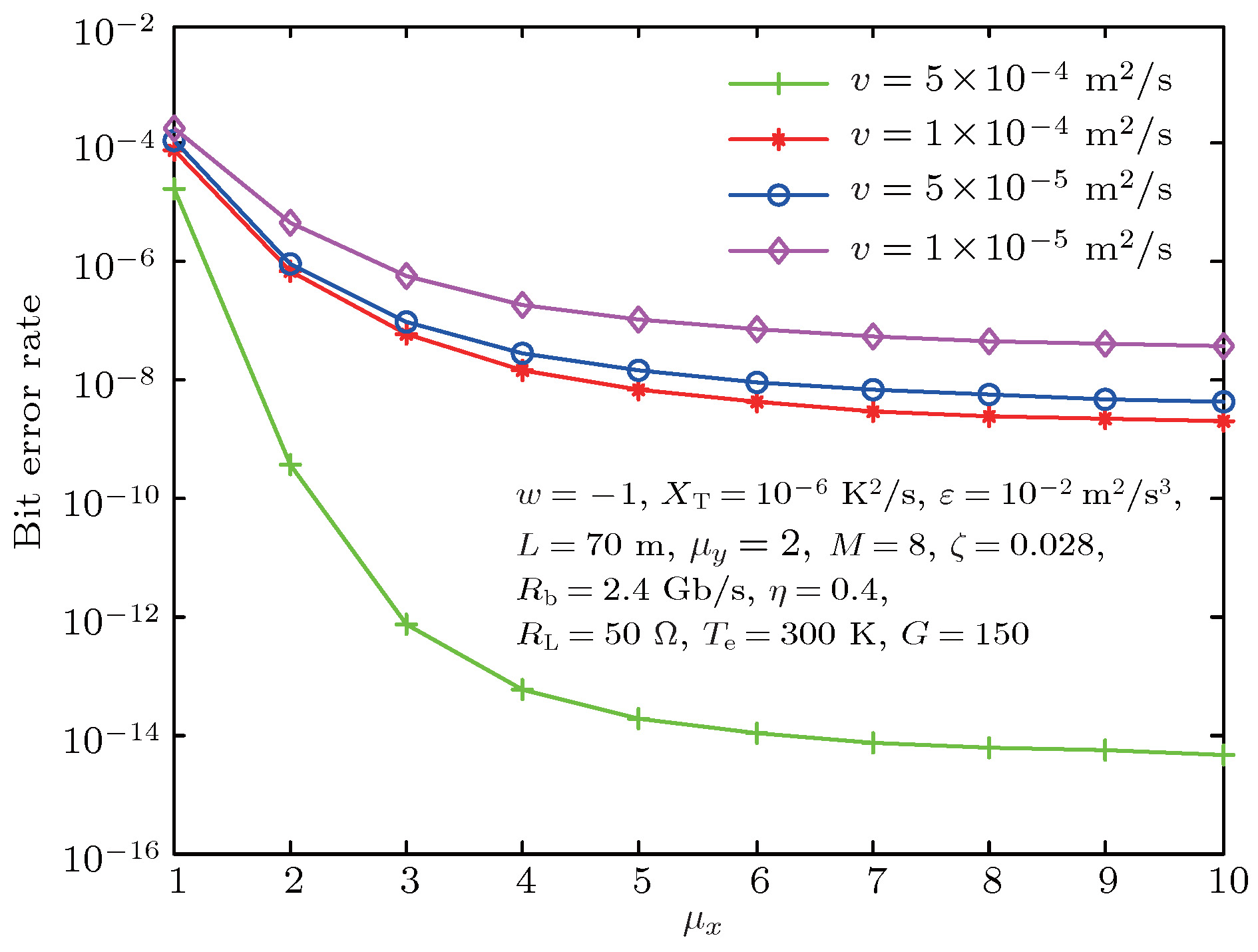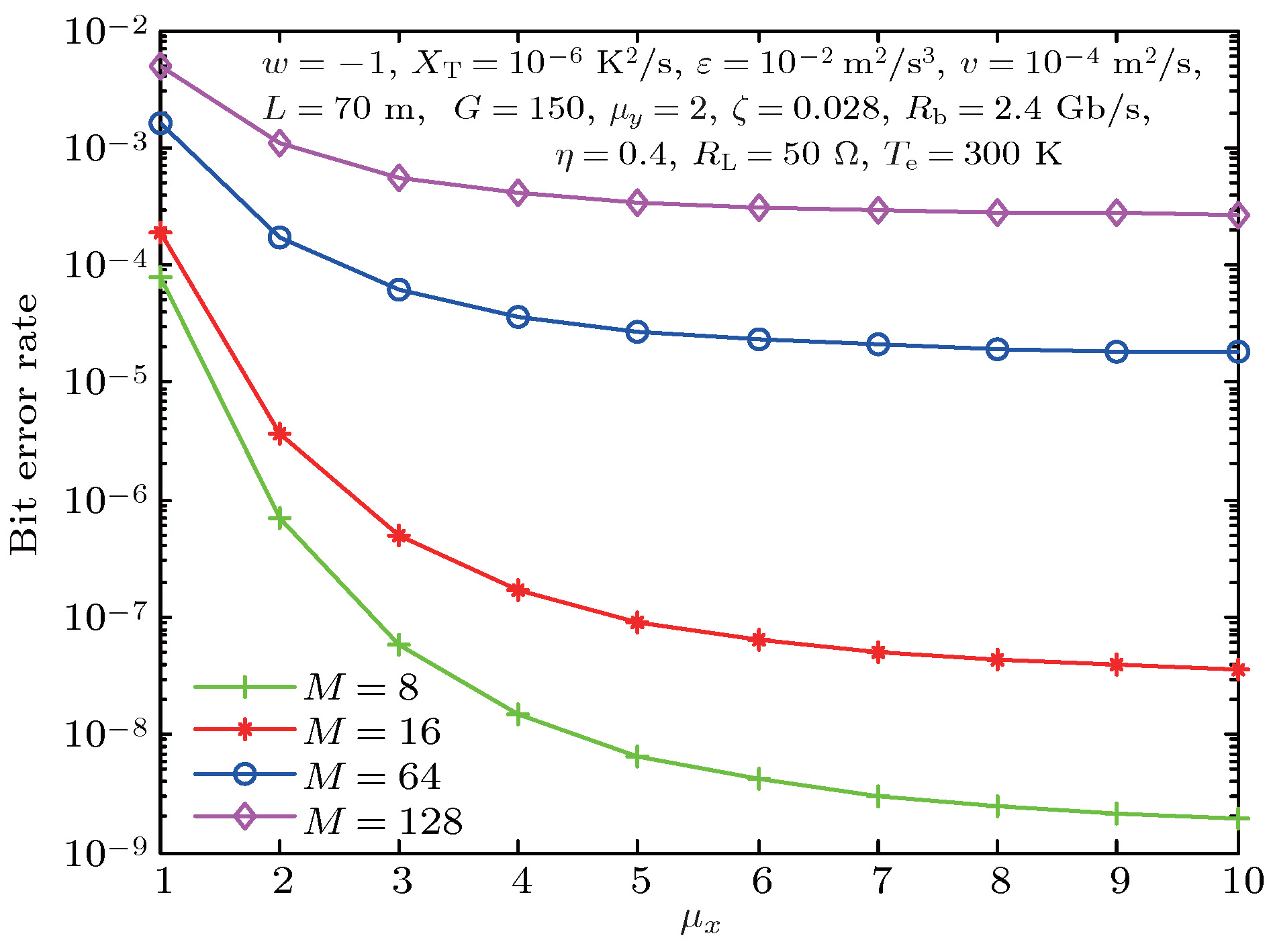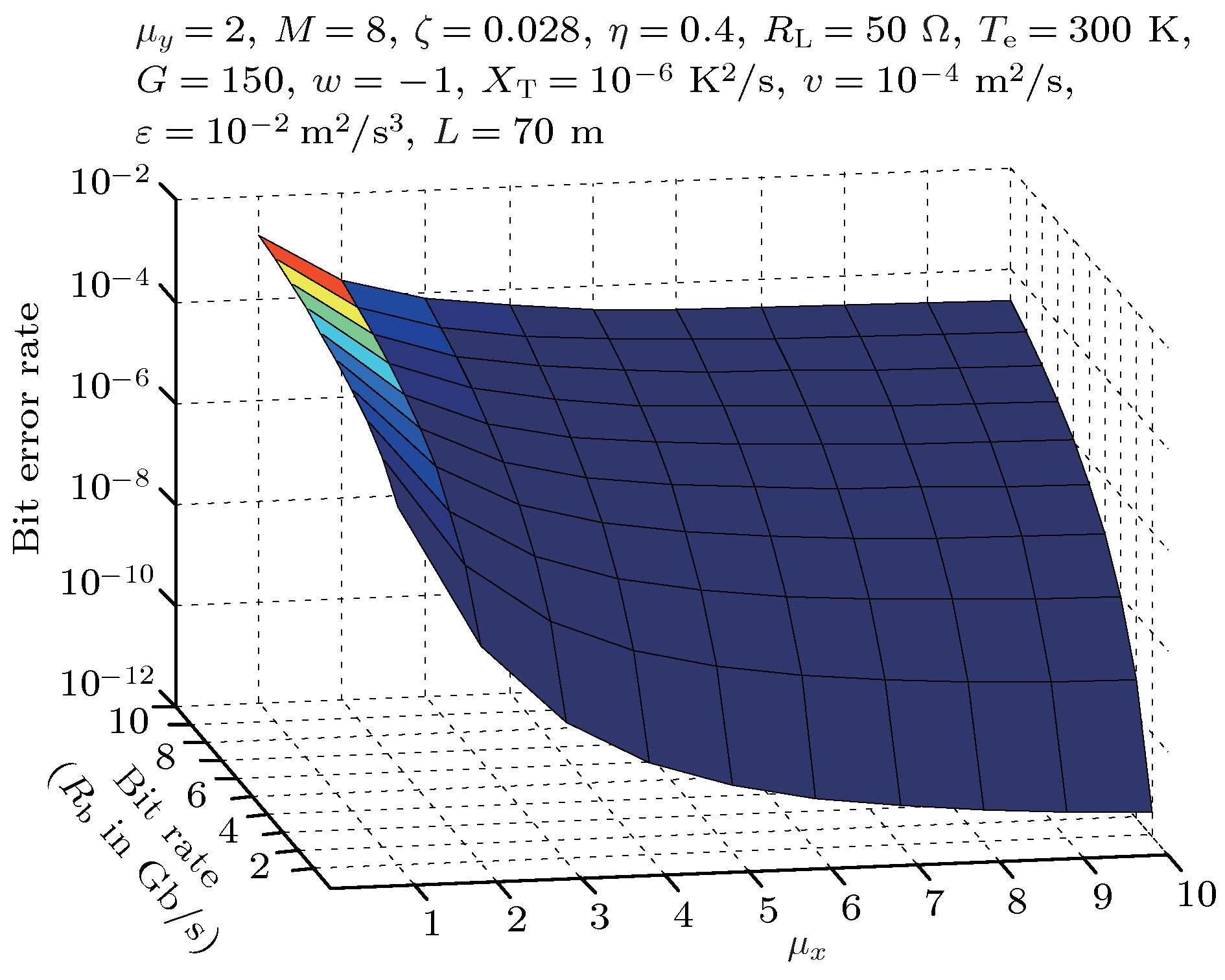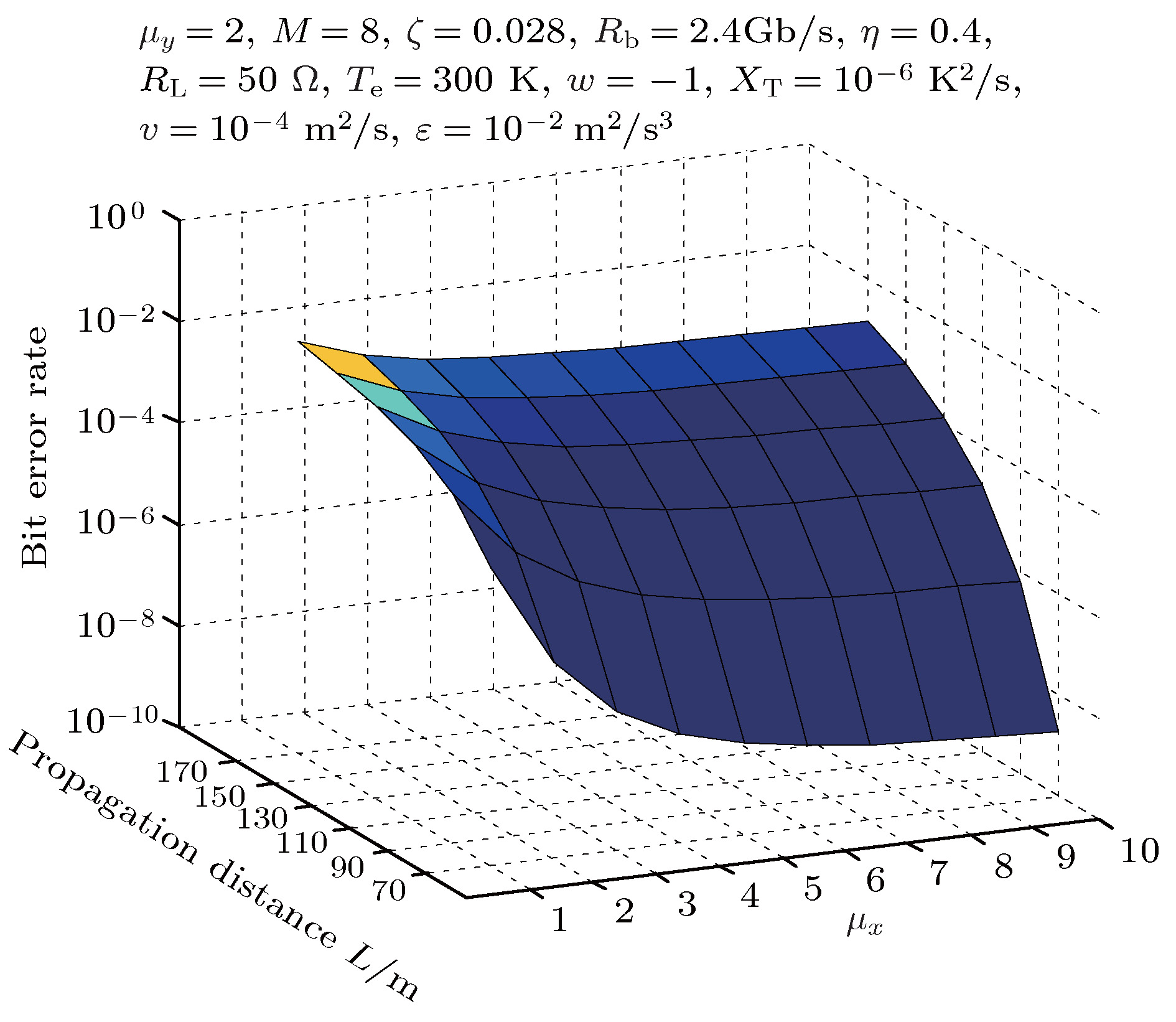-
Pulse position modulation (PPM) technology combined with the system of wireless optical communication received by the photon detector has the advantages of high energy efficiency and strong anti-interference capability. This technology has received extensive attention in the field of underwater wireless optical communication (UWOC) system. Affected by ocean turbulence, the UWOC system will produce the intensity fluctuations, leading the system performance to degrade. The Gamma-gamma intensity fluctuation probability model, which is a two-parameter model, possesses a wide range of applications. It can describe weak, medium and strong fluctuation in light intensity statistics. In this paper, firstly, based on the relationship between the weak atmospheric turbulent spherical wave scintillation index and the weak ocean anisotropic turbulent spherical wave scintillation index, the equivalent structural parameter expressed by both ocean turbulence parameters and anisotropy factor is derived. Then, using the structural parameter combined with the gamma-gamma turbulence channel and the asymptotic Rytov theory, the bit error rate (BER) under anisotropic ocean turbulence is calculated based on the BER formula of the PPM communication system. Finally, numerical simulations are carried out to analyze the ocean turbulence parameters, the average avalanche photodiode (APD) gain, the PPM modulation order, the data bit rate, and the influences of transmission distance on the BER under different anisotropic ocean turbulences. The results indicate that the negative effect of turbulence becomes stronger with increasing the ratio between the contributions of temperature and salinity to the refractive index spectrum, the dissipation rate of mean-squared temperature, data bit rate, and propagation distance. As the viscosity coefficient increases, the BER decreases. When the isotropic ocean turbulence and the anisotropy factors are very small, the increase of the rate of dissipation of kinetic energy per unit mass of fluid will result in a decrease in BER. When the turbulent environment anisotropy is further strengthened, the BER first increases and then decreases as the rate of dissipation of kinetic energy per unit mass of fluid increases. As the average APD gain increases, the BER first decreases and then increases. This trend is especially noticeable as the anisotropy factor increases. The choice of the average APD gain is important for finding the minimum value of the BER. In general, the system is more affected by salinity fluctuation than by temperature fluctuation. As the rate of dissipation of mean-squared temperature increases and the viscosity coefficient decreases, the negative effects of turbulence becomes more and more serious. When the system propagates longer distances or works at a higher data bit rate, the system is severely affected by turbulence, which limits the system operating distance and data transmission rate. However, using a smaller modulation order and choosing the right APD can conduce to improving the system performance. In addition, the PPM UWOC system can perform better when the system operates within acceptable bit error rate as the ocean turbulence environment becomes more anisotropic. This study will provide reference for the construction and performance estimation of UWOC system platform.
-
Keywords:
- underwater optical communication /
- bit error rate /
- anisotropic oceanic turbulence /
- gamma-gamma distribution
[1] Nikishov V V, Nikishov V I 2000 Int. J. Fluid Mech. Res. 27 82
 Google Scholar
Google Scholar
[2] Kiasaleh K 2005 IEEE Trans. Commun. 53 1455
 Google Scholar
Google Scholar
[3] Gappmair W, Muhammad S S 2007 Electron. Lett. 43 302
 Google Scholar
Google Scholar
[4] Gappmair W, Muhammad S S 2007 Electron. Lett. 43 880
 Google Scholar
Google Scholar
[5] Yi X, Liu Z J, Yue P, Shang T 2010 6th International Conference on Wireless Communications Networking and Mobile Computing Chengdu, China, September 23−25, 2010 p1
[6] Gappmair W, Hranilovic S, Leitgeb E 2010 IEEE Commun. Lett. 14 468
 Google Scholar
Google Scholar
[7] Saidi H, Tourki K, Hamdi N 2016 International Symposium on Signal, Image, Video and Communications Tunis, Tunisia, November 21—23, 2016 p207
[8] Barua B, Hossain M M 2012 15th International Conference on Computer and Information Technology Chittagong, Bangladesh, December 22−24, 2012 p295
[9] Arpali S A, Baykal Y, Arpali Ç 2016 J. Mod. Opt. 63 1297
[10] Gerçekcioğlu H 2014 J. Opt. Soc. Am. A 31 1963
 Google Scholar
Google Scholar
[11] Yousefi M, Golmohammady S, Mashal A, Kashani F D 2015 J. Opt. Soc. Am. A 32 1982
 Google Scholar
Google Scholar
[12] Yi X, Li Z, Liu Z 2015 Appl. Opt. 54 1273
 Google Scholar
Google Scholar
[13] Ata Y, Baykal Y 2018 Appl. Opt. 57 2258
 Google Scholar
Google Scholar
[14] Baykal Y 2018 J. Opt. Soc. Am. A 35 1627
 Google Scholar
Google Scholar
[15] Peppas K P, Boucouvalas A C, Ghassemlooy Z 2017 IET Optoelectron. 11 180
 Google Scholar
Google Scholar
[16] Gökçe M C, Baykal Y, Ata Y 2018 Opt. Commun. 427 573
 Google Scholar
Google Scholar
[17] Baykal Y 2006 J. Opt. Soc. Am. A 23 889
 Google Scholar
Google Scholar
[18] Cui L Y, Xue B X, Zhou F G 2015 Opt. Express 23 30088
 Google Scholar
Google Scholar
[19] Ata Y, Baykal Y 2018 Chin. Opt. Lett. 16 080102
 Google Scholar
Google Scholar
[20] Thorpe S A 2005 The Turbulent Ocean (Oxford: Cambridge University Press) p25
[21] Baykal Y 2018 J. Mod. Opt. 65 825
 Google Scholar
Google Scholar
[22] Baykal Y 2016 Appl. Opt. 55 1228
 Google Scholar
Google Scholar
[23] Wang S J, Baykal Y, Plonus M A 1983 J. Opt. Soc. Am. 73 831
 Google Scholar
Google Scholar
[24] Simon M K, Alouini M S 1998 Proc. IEEE 86 1860
 Google Scholar
Google Scholar
[25] 柯熙政, 邓莉君 2016 无线光通信(北京: 科学出版社)第107−109页
Ke X Z, Deng L J 2016 Wireless Optical Communication (Beijing: Science Press) pp107−109 (in Chinese)
[26] Andrews L C, Phillips R L 2005 Laser Beam Propagation through Random Media (Bellingham, Washington USA: SPIE Press) pp450−454
[27] 郑晓桐, 郭立新, 程明建, 李江挺 2018 67 214206
 Google Scholar
Google Scholar
Zheng X T, Guo L X, Cheng M J, Li J T 2018 Acta Phys. Sin. 67 214206
 Google Scholar
Google Scholar
[28] Cui L Y, Cao L 2015 Optik 126 4704
 Google Scholar
Google Scholar
-
-
[1] Nikishov V V, Nikishov V I 2000 Int. J. Fluid Mech. Res. 27 82
 Google Scholar
Google Scholar
[2] Kiasaleh K 2005 IEEE Trans. Commun. 53 1455
 Google Scholar
Google Scholar
[3] Gappmair W, Muhammad S S 2007 Electron. Lett. 43 302
 Google Scholar
Google Scholar
[4] Gappmair W, Muhammad S S 2007 Electron. Lett. 43 880
 Google Scholar
Google Scholar
[5] Yi X, Liu Z J, Yue P, Shang T 2010 6th International Conference on Wireless Communications Networking and Mobile Computing Chengdu, China, September 23−25, 2010 p1
[6] Gappmair W, Hranilovic S, Leitgeb E 2010 IEEE Commun. Lett. 14 468
 Google Scholar
Google Scholar
[7] Saidi H, Tourki K, Hamdi N 2016 International Symposium on Signal, Image, Video and Communications Tunis, Tunisia, November 21—23, 2016 p207
[8] Barua B, Hossain M M 2012 15th International Conference on Computer and Information Technology Chittagong, Bangladesh, December 22−24, 2012 p295
[9] Arpali S A, Baykal Y, Arpali Ç 2016 J. Mod. Opt. 63 1297
[10] Gerçekcioğlu H 2014 J. Opt. Soc. Am. A 31 1963
 Google Scholar
Google Scholar
[11] Yousefi M, Golmohammady S, Mashal A, Kashani F D 2015 J. Opt. Soc. Am. A 32 1982
 Google Scholar
Google Scholar
[12] Yi X, Li Z, Liu Z 2015 Appl. Opt. 54 1273
 Google Scholar
Google Scholar
[13] Ata Y, Baykal Y 2018 Appl. Opt. 57 2258
 Google Scholar
Google Scholar
[14] Baykal Y 2018 J. Opt. Soc. Am. A 35 1627
 Google Scholar
Google Scholar
[15] Peppas K P, Boucouvalas A C, Ghassemlooy Z 2017 IET Optoelectron. 11 180
 Google Scholar
Google Scholar
[16] Gökçe M C, Baykal Y, Ata Y 2018 Opt. Commun. 427 573
 Google Scholar
Google Scholar
[17] Baykal Y 2006 J. Opt. Soc. Am. A 23 889
 Google Scholar
Google Scholar
[18] Cui L Y, Xue B X, Zhou F G 2015 Opt. Express 23 30088
 Google Scholar
Google Scholar
[19] Ata Y, Baykal Y 2018 Chin. Opt. Lett. 16 080102
 Google Scholar
Google Scholar
[20] Thorpe S A 2005 The Turbulent Ocean (Oxford: Cambridge University Press) p25
[21] Baykal Y 2018 J. Mod. Opt. 65 825
 Google Scholar
Google Scholar
[22] Baykal Y 2016 Appl. Opt. 55 1228
 Google Scholar
Google Scholar
[23] Wang S J, Baykal Y, Plonus M A 1983 J. Opt. Soc. Am. 73 831
 Google Scholar
Google Scholar
[24] Simon M K, Alouini M S 1998 Proc. IEEE 86 1860
 Google Scholar
Google Scholar
[25] 柯熙政, 邓莉君 2016 无线光通信(北京: 科学出版社)第107−109页
Ke X Z, Deng L J 2016 Wireless Optical Communication (Beijing: Science Press) pp107−109 (in Chinese)
[26] Andrews L C, Phillips R L 2005 Laser Beam Propagation through Random Media (Bellingham, Washington USA: SPIE Press) pp450−454
[27] 郑晓桐, 郭立新, 程明建, 李江挺 2018 67 214206
 Google Scholar
Google Scholar
Zheng X T, Guo L X, Cheng M J, Li J T 2018 Acta Phys. Sin. 67 214206
 Google Scholar
Google Scholar
[28] Cui L Y, Cao L 2015 Optik 126 4704
 Google Scholar
Google Scholar
Catalog
Metrics
- Abstract views: 12262
- PDF Downloads: 171
- Cited By: 0














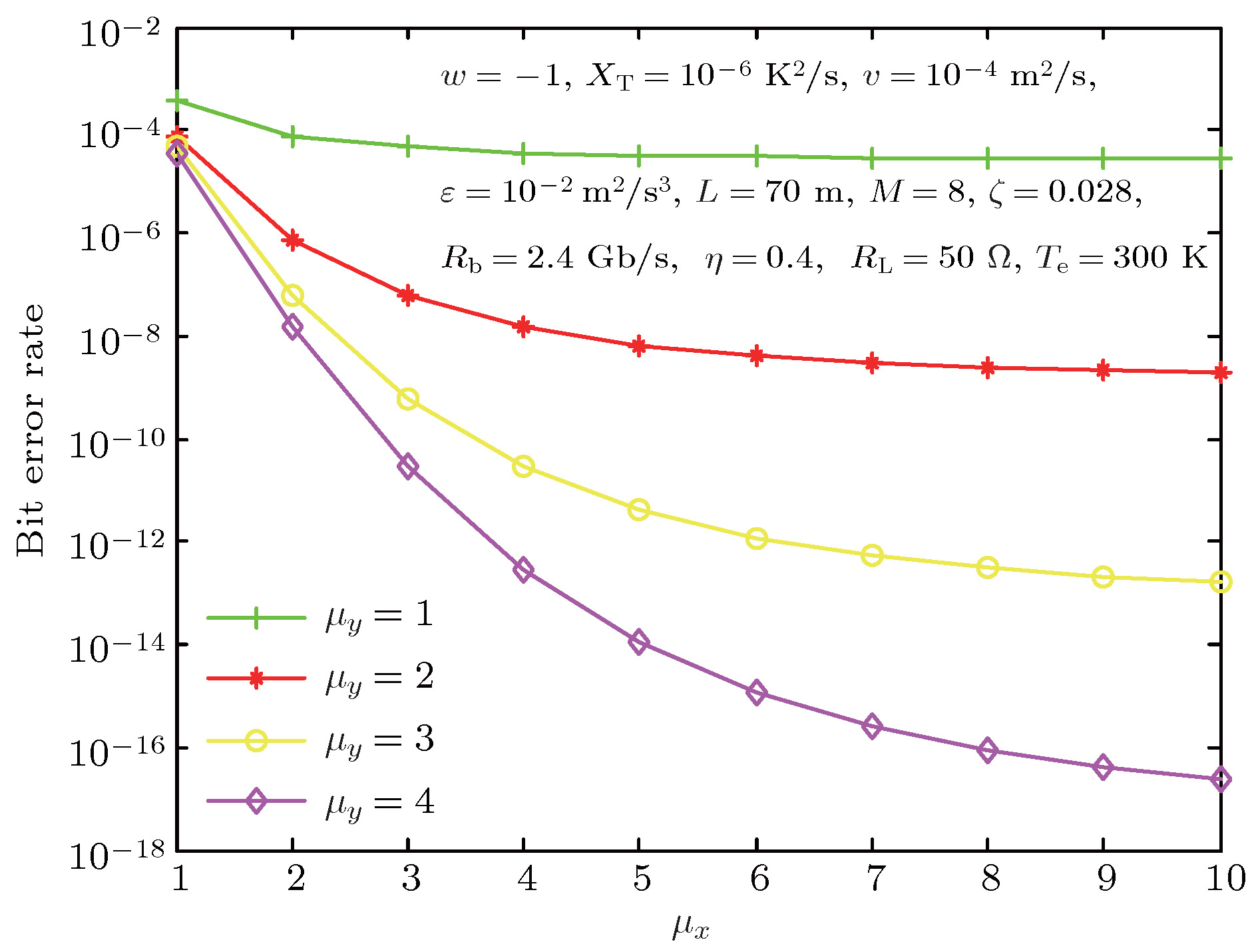


 DownLoad:
DownLoad:
